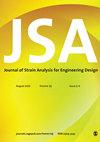表面相互作用和阻尼对功能梯度纳米管增强扭转微镜执行器机电稳定性的耦合影响
IF 1.8
4区 工程技术
Q3 ENGINEERING, MECHANICAL
Journal of Strain Analysis for Engineering Design
Pub Date : 2021-08-01
DOI:10.1177/03093247211036826
引用次数: 4
摘要
研究了热卡西米尔力和挤压膜阻尼(SFD)的耦合表面效应对扭转微镜作动器机电稳定性和分岔的影响。推导了微镜系统的控制方程,得到了系统的拉入电压和临界倾斜角。此外,功能梯度碳纳米管增强复合材料(FG-CNTRC)可以调节扭转纳米梁的扭转变形。在COMSOL Multiphysics平台上建立了有限元分析(FEA)模型,并利用热卡西米尔力对拉入不稳定性的影响进行了仿真验证。结果表明,数值计算结果与本文的理论结果和文献中的实验数据吻合较好。此外,还详细讨论了CNTs的体积分数和几何分布、热卡西米尔力、非局部参数和挤压膜阻尼对电致不稳定性和独立行为的影响。此外,还研究了微镜系统平衡态的演化,描述了周期轨道、同斜轨道和异斜轨道的分岔图和相图。结果表明:FGX-CNTRC型微镜的倾斜角幅值衰减速度比FGO-CNTRC型微镜慢,CNTs体积比的增加减缓了因加强效应引起的衰减。考虑挤压膜阻尼时,由于热卡西米尔力的作用,系统稳定中心点演化为一个轨道同斜的焦点,系统保持两个轨道异斜的不稳定鞍点。本文章由计算机程序翻译,如有差异,请以英文原文为准。
Coupled effects of surface interaction and damping on electromechanical stability of functionally graded nanotubes reinforced torsional micromirror actuator
This paper demonstrated the coupled surface effects of thermal Casimir force and squeeze film damping (SFD) on size-dependent electromechanical stability and bifurcation of torsion micromirror actuator. The governing equations of micromirror system are derived, and the pull-in voltage and critical tilting angle are obtained. Also, the twisting deformation of torsion nanobeam can be tuned by functionally graded carbon nanotubes reinforced composites (FG-CNTRC). A finite element analysis (FEA) model is established on the COMSOL Multiphysics platform, and the simulation of the effect of thermal Casimir force on pull-in instability is utilized to verify the present analytical model. The results indicate that the numerical results well agree with the theoretical results in this work and experimental data in the literature. Further, the influences of volume fraction and geometrical distribution of CNTs, thermal Casimir force, nonlocal parameter, and squeeze film damping on electrically actuated instability and free-standing behavior are detailedly discussed. Besides, the evolution of equilibrium states of micromirror system is investigated, and bifurcation diagrams and phase portraits including the periodic, homoclinic, and heteroclinic orbits are described as well. The results demonstrated that the amplitude of the tilting angle for FGX-CNTRC type micromirror attenuates slower than for FGO-CNTRC type, and the increment of CNTs volume ratio slows down the attenuation due to the stiffening effect. When considering squeeze film damping, the stable center point evolves into one focus point with homoclinic orbits, and the dynamic system maintains two unstable saddle points with the heteroclinic orbits due to the effect of thermal Casimir force.
求助全文
通过发布文献求助,成功后即可免费获取论文全文。
去求助
来源期刊

Journal of Strain Analysis for Engineering Design
工程技术-材料科学:表征与测试
CiteScore
3.50
自引率
6.20%
发文量
25
审稿时长
>12 weeks
期刊介绍:
The Journal of Strain Analysis for Engineering Design provides a forum for work relating to the measurement and analysis of strain that is appropriate to engineering design and practice.
"Since launching in 1965, The Journal of Strain Analysis has been a collegiate effort, dedicated to providing exemplary service to our authors. We welcome contributions related to analytical, experimental, and numerical techniques for the analysis and/or measurement of stress and/or strain, or studies of relevant material properties and failure modes. Our international Editorial Board contains experts in all of these fields and is keen to encourage papers on novel techniques and innovative applications." Professor Eann Patterson - University of Liverpool, UK
This journal is a member of the Committee on Publication Ethics (COPE).
 求助内容:
求助内容: 应助结果提醒方式:
应助结果提醒方式:


